Child and Elderly Abuse Assessment: A Comprehensive Case Analysis
VerifiedAdded on 2020/04/01
|8
|1772
|95
Report
AI Summary
This report provides a detailed assessment of child and elderly abuse cases, focusing on two specific scenarios. The first part of the report outlines a questionnaire and identifies key individuals and resources for assessing a young woman named Jane, who has a history of abuse and neglect, learning difficulties, and self-harm, and is now in foster care. The second part of the report delves deeper into Jane's case, discussing the impact of her childhood experiences, the need for counseling and support, and the implications of attachment theory. The third part addresses a separate case involving a child named Tony and his grandmother, who are both experiencing abuse. The assessment outlines steps to be taken, including gathering information, contacting authorities, and ensuring the safety and well-being of the victims, while also discussing legal and ethical obligations. The report emphasizes the importance of intervention, protection, and support for both the child and the elderly victim, highlighting the role of social workers, therapists, and legal professionals.
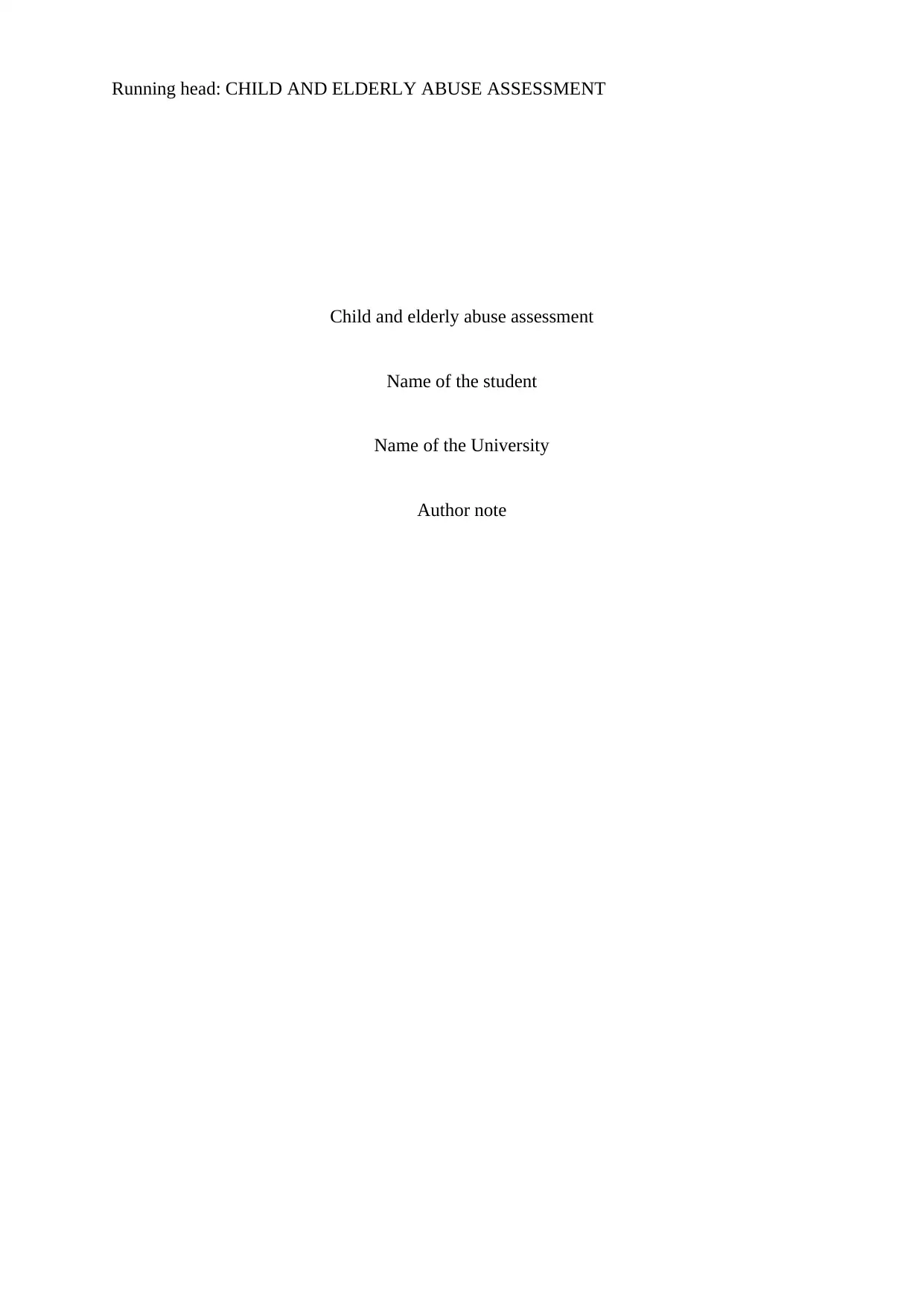
Running head: CHILD AND ELDERLY ABUSE ASSESSMENT
Child and elderly abuse assessment
Name of the student
Name of the University
Author note
Child and elderly abuse assessment
Name of the student
Name of the University
Author note
Paraphrase This Document
Need a fresh take? Get an instant paraphrase of this document with our AI Paraphraser
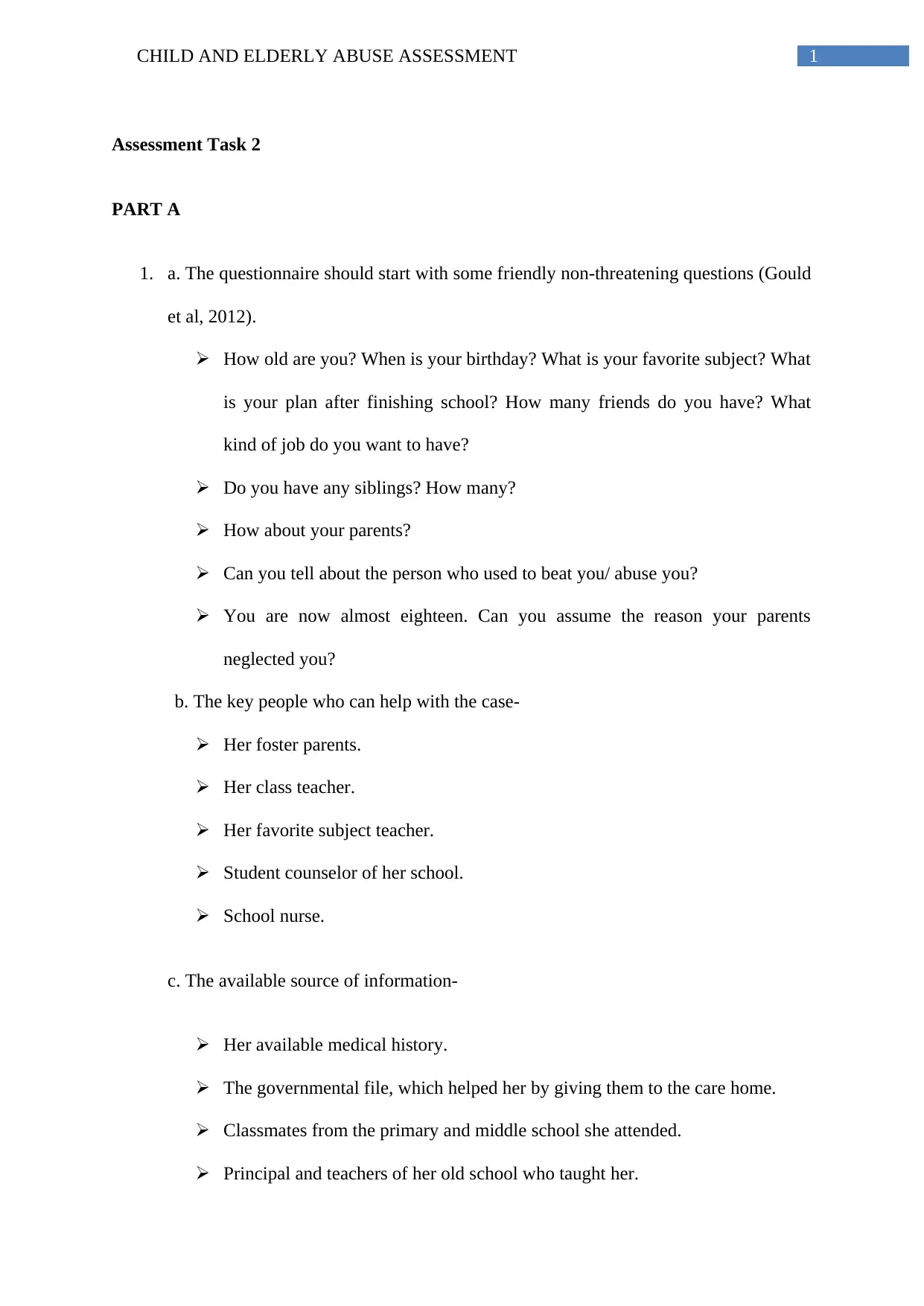
1CHILD AND ELDERLY ABUSE ASSESSMENT
Assessment Task 2
PART A
1. a. The questionnaire should start with some friendly non-threatening questions (Gould
et al, 2012).
How old are you? When is your birthday? What is your favorite subject? What
is your plan after finishing school? How many friends do you have? What
kind of job do you want to have?
Do you have any siblings? How many?
How about your parents?
Can you tell about the person who used to beat you/ abuse you?
You are now almost eighteen. Can you assume the reason your parents
neglected you?
b. The key people who can help with the case-
Her foster parents.
Her class teacher.
Her favorite subject teacher.
Student counselor of her school.
School nurse.
c. The available source of information-
Her available medical history.
The governmental file, which helped her by giving them to the care home.
Classmates from the primary and middle school she attended.
Principal and teachers of her old school who taught her.
Assessment Task 2
PART A
1. a. The questionnaire should start with some friendly non-threatening questions (Gould
et al, 2012).
How old are you? When is your birthday? What is your favorite subject? What
is your plan after finishing school? How many friends do you have? What
kind of job do you want to have?
Do you have any siblings? How many?
How about your parents?
Can you tell about the person who used to beat you/ abuse you?
You are now almost eighteen. Can you assume the reason your parents
neglected you?
b. The key people who can help with the case-
Her foster parents.
Her class teacher.
Her favorite subject teacher.
Student counselor of her school.
School nurse.
c. The available source of information-
Her available medical history.
The governmental file, which helped her by giving them to the care home.
Classmates from the primary and middle school she attended.
Principal and teachers of her old school who taught her.

2CHILD AND ELDERLY ABUSE ASSESSMENT
The people and neighbors of her parents who knew her and her family as a
child.
d. The observation setting should be friendly and according to the preference of Jane.
This will make her be easy with the caseworker.
PART B
Introduction:
The girl Jane is on the verge of being an adult as she is seventeen years and ten
months old. She has been living in foster care from the age of ten. Before she came to the
foster care, she was constantly abused and neglected by her own family members (Read and
Bentall 2012). Due to this incident, she faced many negative outcomes in her life like
learning difficulty and self-harm.
Discussion:
The victim has been the subject of abuse from the early childhood. Some studies
showed that the child’s age has a direct effect with neglect and maltreatment. If a child
became sexually abused very early in life, he or she is more likely to suffer from problems.
Jane had the same condition. Because of this, Jane developed some issues like learning
difficulties and self-harm. Just as most of the survivors, Jane has also experienced extreme
emotional turbulence, which led her to feel shame and self-blame (Read and Bentall 2012).
As it is been studied that the woman survivor with emotional problem always remains
at risk of being a victim as they suffer from low self-esteem. Jane should attend counseling
with a recommended therapist thrice a week and follow the prescription of the doctor. Her
foster parents should have also been supportive to her. The foster parents should start trusting
The people and neighbors of her parents who knew her and her family as a
child.
d. The observation setting should be friendly and according to the preference of Jane.
This will make her be easy with the caseworker.
PART B
Introduction:
The girl Jane is on the verge of being an adult as she is seventeen years and ten
months old. She has been living in foster care from the age of ten. Before she came to the
foster care, she was constantly abused and neglected by her own family members (Read and
Bentall 2012). Due to this incident, she faced many negative outcomes in her life like
learning difficulty and self-harm.
Discussion:
The victim has been the subject of abuse from the early childhood. Some studies
showed that the child’s age has a direct effect with neglect and maltreatment. If a child
became sexually abused very early in life, he or she is more likely to suffer from problems.
Jane had the same condition. Because of this, Jane developed some issues like learning
difficulties and self-harm. Just as most of the survivors, Jane has also experienced extreme
emotional turbulence, which led her to feel shame and self-blame (Read and Bentall 2012).
As it is been studied that the woman survivor with emotional problem always remains
at risk of being a victim as they suffer from low self-esteem. Jane should attend counseling
with a recommended therapist thrice a week and follow the prescription of the doctor. Her
foster parents should have also been supportive to her. The foster parents should start trusting
⊘ This is a preview!⊘
Do you want full access?
Subscribe today to unlock all pages.

Trusted by 1+ million students worldwide
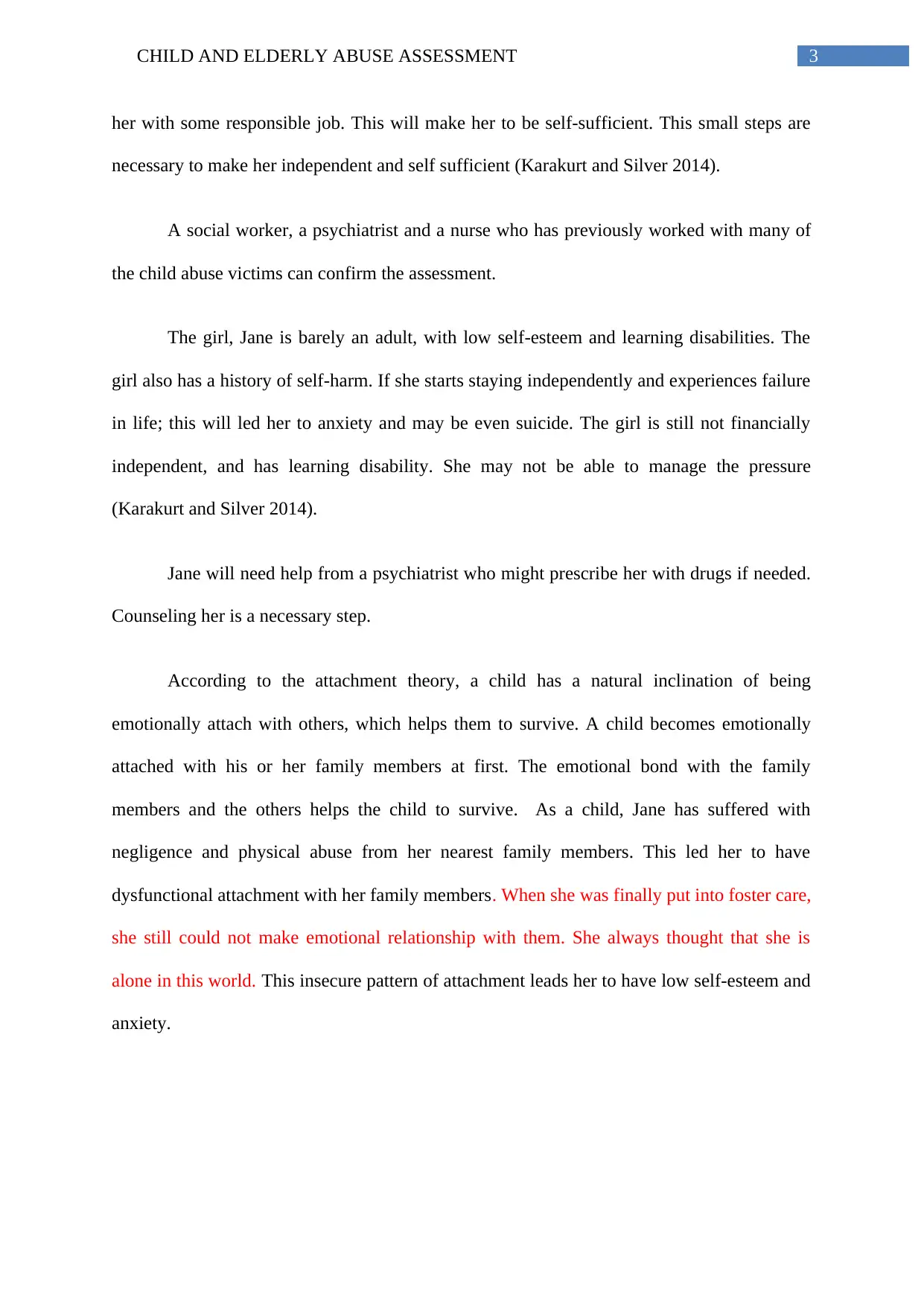
3CHILD AND ELDERLY ABUSE ASSESSMENT
her with some responsible job. This will make her to be self-sufficient. This small steps are
necessary to make her independent and self sufficient (Karakurt and Silver 2014).
A social worker, a psychiatrist and a nurse who has previously worked with many of
the child abuse victims can confirm the assessment.
The girl, Jane is barely an adult, with low self-esteem and learning disabilities. The
girl also has a history of self-harm. If she starts staying independently and experiences failure
in life; this will led her to anxiety and may be even suicide. The girl is still not financially
independent, and has learning disability. She may not be able to manage the pressure
(Karakurt and Silver 2014).
Jane will need help from a psychiatrist who might prescribe her with drugs if needed.
Counseling her is a necessary step.
According to the attachment theory, a child has a natural inclination of being
emotionally attach with others, which helps them to survive. A child becomes emotionally
attached with his or her family members at first. The emotional bond with the family
members and the others helps the child to survive. As a child, Jane has suffered with
negligence and physical abuse from her nearest family members. This led her to have
dysfunctional attachment with her family members. When she was finally put into foster care,
she still could not make emotional relationship with them. She always thought that she is
alone in this world. This insecure pattern of attachment leads her to have low self-esteem and
anxiety.
her with some responsible job. This will make her to be self-sufficient. This small steps are
necessary to make her independent and self sufficient (Karakurt and Silver 2014).
A social worker, a psychiatrist and a nurse who has previously worked with many of
the child abuse victims can confirm the assessment.
The girl, Jane is barely an adult, with low self-esteem and learning disabilities. The
girl also has a history of self-harm. If she starts staying independently and experiences failure
in life; this will led her to anxiety and may be even suicide. The girl is still not financially
independent, and has learning disability. She may not be able to manage the pressure
(Karakurt and Silver 2014).
Jane will need help from a psychiatrist who might prescribe her with drugs if needed.
Counseling her is a necessary step.
According to the attachment theory, a child has a natural inclination of being
emotionally attach with others, which helps them to survive. A child becomes emotionally
attached with his or her family members at first. The emotional bond with the family
members and the others helps the child to survive. As a child, Jane has suffered with
negligence and physical abuse from her nearest family members. This led her to have
dysfunctional attachment with her family members. When she was finally put into foster care,
she still could not make emotional relationship with them. She always thought that she is
alone in this world. This insecure pattern of attachment leads her to have low self-esteem and
anxiety.
Paraphrase This Document
Need a fresh take? Get an instant paraphrase of this document with our AI Paraphraser
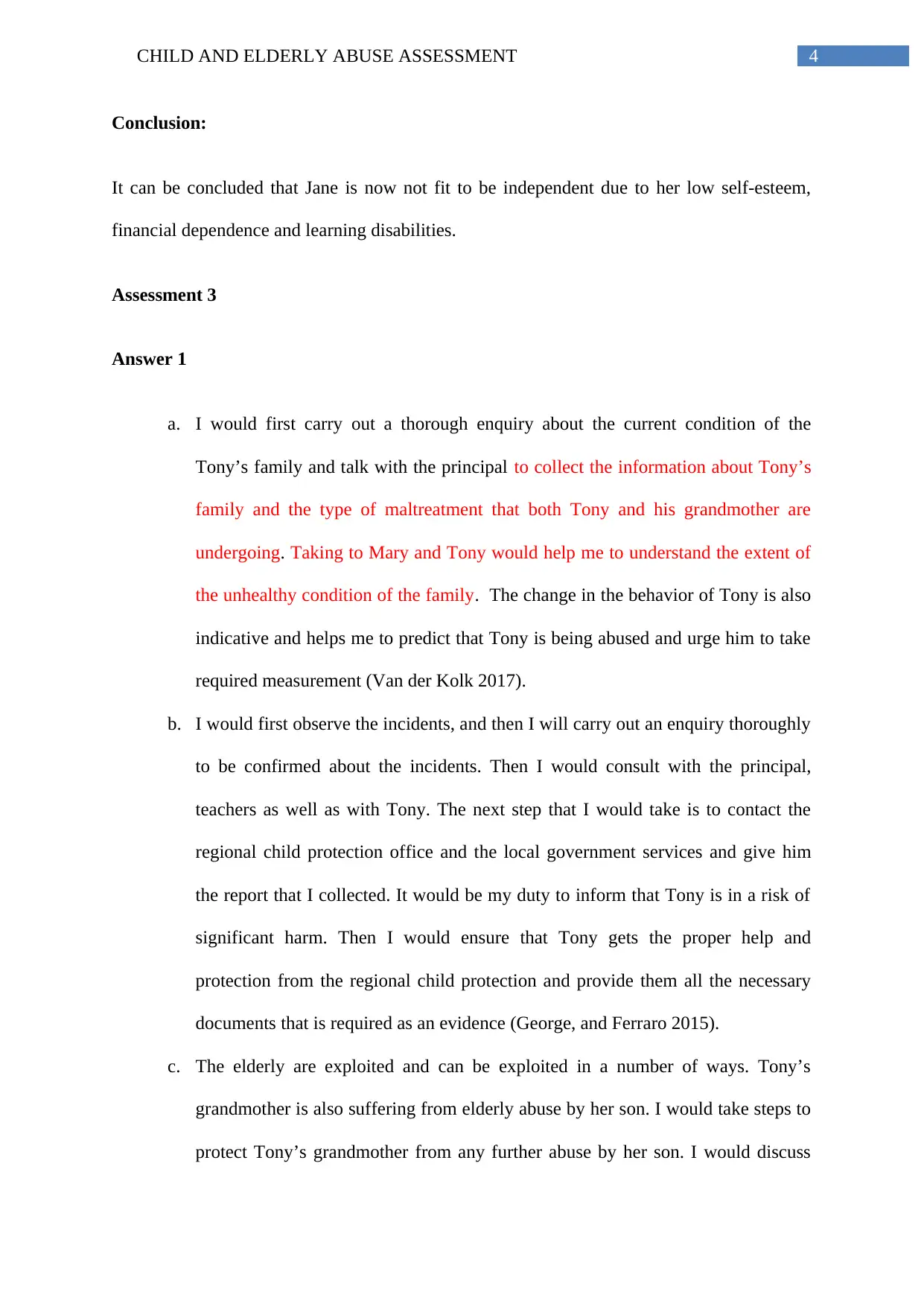
4CHILD AND ELDERLY ABUSE ASSESSMENT
Conclusion:
It can be concluded that Jane is now not fit to be independent due to her low self-esteem,
financial dependence and learning disabilities.
Assessment 3
Answer 1
a. I would first carry out a thorough enquiry about the current condition of the
Tony’s family and talk with the principal to collect the information about Tony’s
family and the type of maltreatment that both Tony and his grandmother are
undergoing. Taking to Mary and Tony would help me to understand the extent of
the unhealthy condition of the family. The change in the behavior of Tony is also
indicative and helps me to predict that Tony is being abused and urge him to take
required measurement (Van der Kolk 2017).
b. I would first observe the incidents, and then I will carry out an enquiry thoroughly
to be confirmed about the incidents. Then I would consult with the principal,
teachers as well as with Tony. The next step that I would take is to contact the
regional child protection office and the local government services and give him
the report that I collected. It would be my duty to inform that Tony is in a risk of
significant harm. Then I would ensure that Tony gets the proper help and
protection from the regional child protection and provide them all the necessary
documents that is required as an evidence (George, and Ferraro 2015).
c. The elderly are exploited and can be exploited in a number of ways. Tony’s
grandmother is also suffering from elderly abuse by her son. I would take steps to
protect Tony’s grandmother from any further abuse by her son. I would discuss
Conclusion:
It can be concluded that Jane is now not fit to be independent due to her low self-esteem,
financial dependence and learning disabilities.
Assessment 3
Answer 1
a. I would first carry out a thorough enquiry about the current condition of the
Tony’s family and talk with the principal to collect the information about Tony’s
family and the type of maltreatment that both Tony and his grandmother are
undergoing. Taking to Mary and Tony would help me to understand the extent of
the unhealthy condition of the family. The change in the behavior of Tony is also
indicative and helps me to predict that Tony is being abused and urge him to take
required measurement (Van der Kolk 2017).
b. I would first observe the incidents, and then I will carry out an enquiry thoroughly
to be confirmed about the incidents. Then I would consult with the principal,
teachers as well as with Tony. The next step that I would take is to contact the
regional child protection office and the local government services and give him
the report that I collected. It would be my duty to inform that Tony is in a risk of
significant harm. Then I would ensure that Tony gets the proper help and
protection from the regional child protection and provide them all the necessary
documents that is required as an evidence (George, and Ferraro 2015).
c. The elderly are exploited and can be exploited in a number of ways. Tony’s
grandmother is also suffering from elderly abuse by her son. I would take steps to
protect Tony’s grandmother from any further abuse by her son. I would discuss
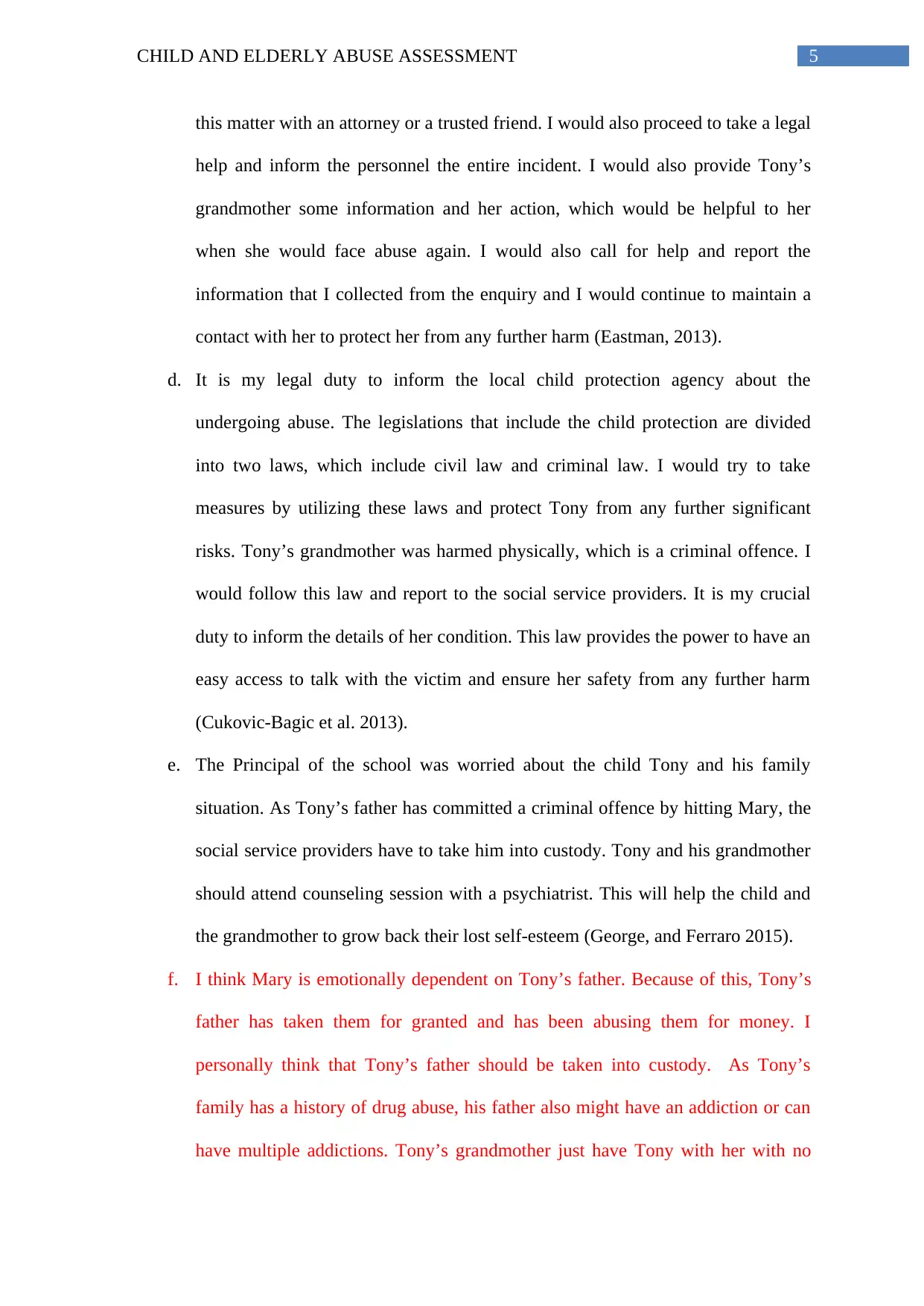
5CHILD AND ELDERLY ABUSE ASSESSMENT
this matter with an attorney or a trusted friend. I would also proceed to take a legal
help and inform the personnel the entire incident. I would also provide Tony’s
grandmother some information and her action, which would be helpful to her
when she would face abuse again. I would also call for help and report the
information that I collected from the enquiry and I would continue to maintain a
contact with her to protect her from any further harm (Eastman, 2013).
d. It is my legal duty to inform the local child protection agency about the
undergoing abuse. The legislations that include the child protection are divided
into two laws, which include civil law and criminal law. I would try to take
measures by utilizing these laws and protect Tony from any further significant
risks. Tony’s grandmother was harmed physically, which is a criminal offence. I
would follow this law and report to the social service providers. It is my crucial
duty to inform the details of her condition. This law provides the power to have an
easy access to talk with the victim and ensure her safety from any further harm
(Cukovic-Bagic et al. 2013).
e. The Principal of the school was worried about the child Tony and his family
situation. As Tony’s father has committed a criminal offence by hitting Mary, the
social service providers have to take him into custody. Tony and his grandmother
should attend counseling session with a psychiatrist. This will help the child and
the grandmother to grow back their lost self-esteem (George, and Ferraro 2015).
f. I think Mary is emotionally dependent on Tony’s father. Because of this, Tony’s
father has taken them for granted and has been abusing them for money. I
personally think that Tony’s father should be taken into custody. As Tony’s
family has a history of drug abuse, his father also might have an addiction or can
have multiple addictions. Tony’s grandmother just have Tony with her with no
this matter with an attorney or a trusted friend. I would also proceed to take a legal
help and inform the personnel the entire incident. I would also provide Tony’s
grandmother some information and her action, which would be helpful to her
when she would face abuse again. I would also call for help and report the
information that I collected from the enquiry and I would continue to maintain a
contact with her to protect her from any further harm (Eastman, 2013).
d. It is my legal duty to inform the local child protection agency about the
undergoing abuse. The legislations that include the child protection are divided
into two laws, which include civil law and criminal law. I would try to take
measures by utilizing these laws and protect Tony from any further significant
risks. Tony’s grandmother was harmed physically, which is a criminal offence. I
would follow this law and report to the social service providers. It is my crucial
duty to inform the details of her condition. This law provides the power to have an
easy access to talk with the victim and ensure her safety from any further harm
(Cukovic-Bagic et al. 2013).
e. The Principal of the school was worried about the child Tony and his family
situation. As Tony’s father has committed a criminal offence by hitting Mary, the
social service providers have to take him into custody. Tony and his grandmother
should attend counseling session with a psychiatrist. This will help the child and
the grandmother to grow back their lost self-esteem (George, and Ferraro 2015).
f. I think Mary is emotionally dependent on Tony’s father. Because of this, Tony’s
father has taken them for granted and has been abusing them for money. I
personally think that Tony’s father should be taken into custody. As Tony’s
family has a history of drug abuse, his father also might have an addiction or can
have multiple addictions. Tony’s grandmother just have Tony with her with no
⊘ This is a preview!⊘
Do you want full access?
Subscribe today to unlock all pages.

Trusted by 1+ million students worldwide
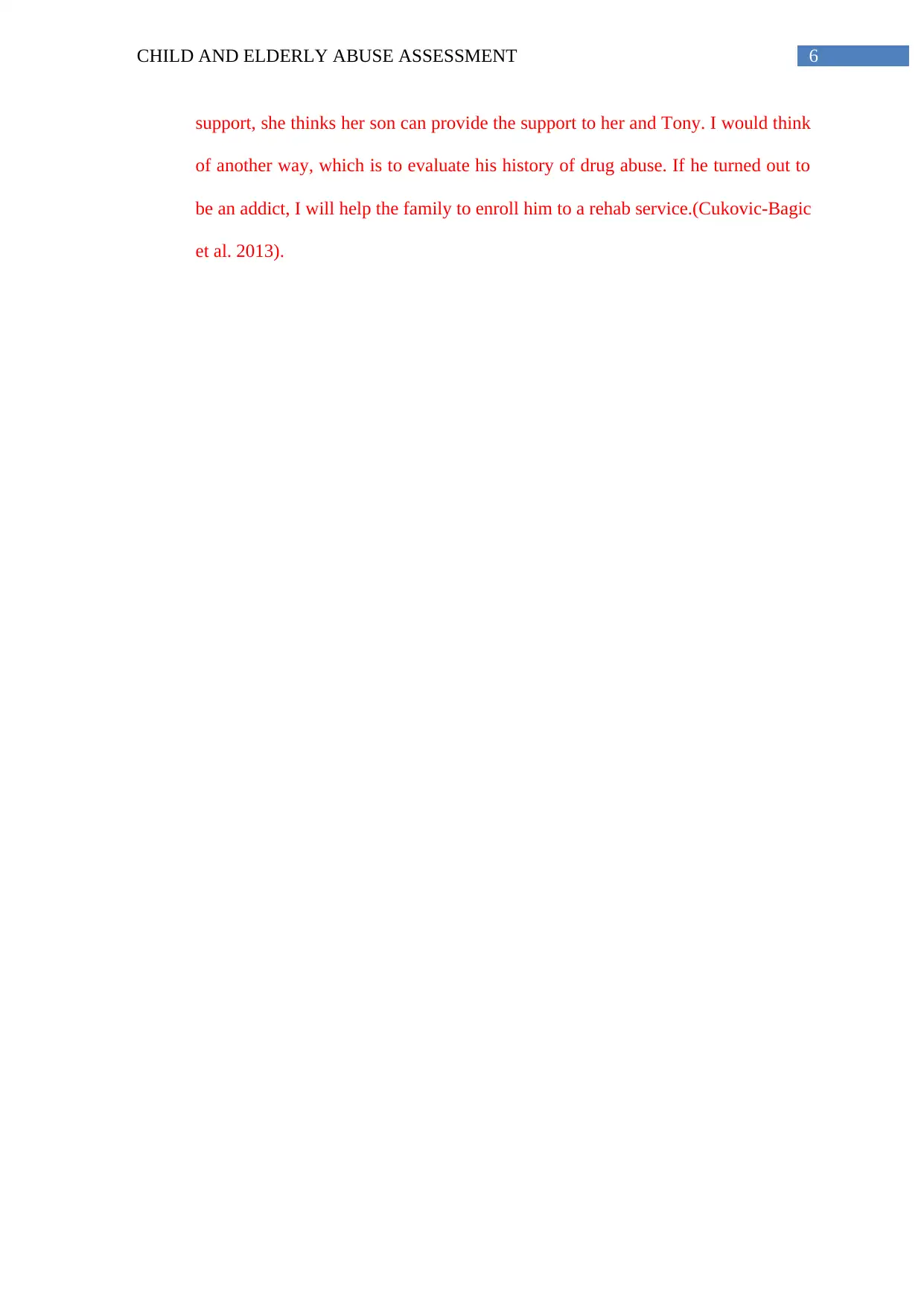
6CHILD AND ELDERLY ABUSE ASSESSMENT
support, she thinks her son can provide the support to her and Tony. I would think
of another way, which is to evaluate his history of drug abuse. If he turned out to
be an addict, I will help the family to enroll him to a rehab service.(Cukovic-Bagic
et al. 2013).
support, she thinks her son can provide the support to her and Tony. I would think
of another way, which is to evaluate his history of drug abuse. If he turned out to
be an addict, I will help the family to enroll him to a rehab service.(Cukovic-Bagic
et al. 2013).
Paraphrase This Document
Need a fresh take? Get an instant paraphrase of this document with our AI Paraphraser
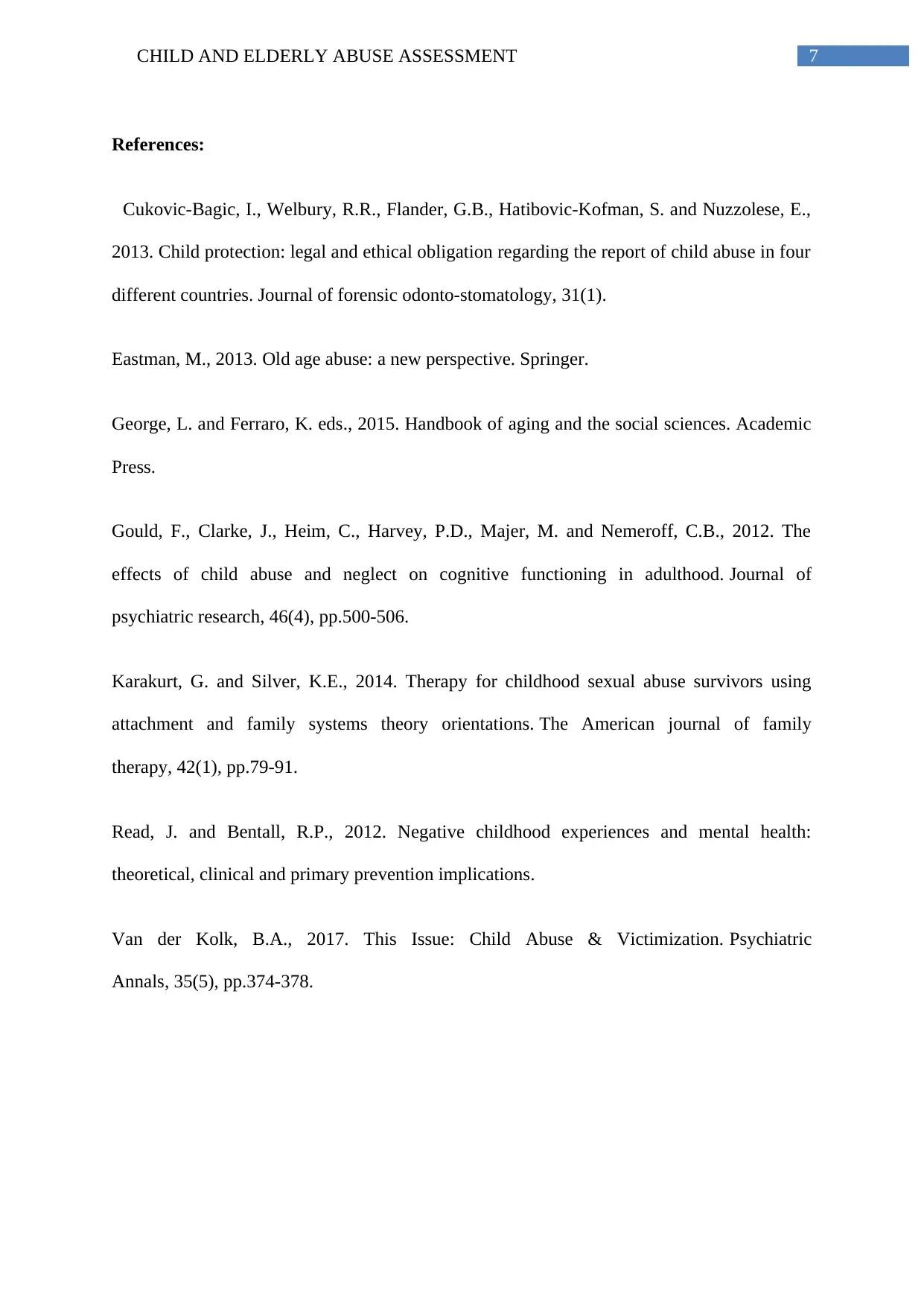
7CHILD AND ELDERLY ABUSE ASSESSMENT
References:
Cukovic-Bagic, I., Welbury, R.R., Flander, G.B., Hatibovic-Kofman, S. and Nuzzolese, E.,
2013. Child protection: legal and ethical obligation regarding the report of child abuse in four
different countries. Journal of forensic odonto-stomatology, 31(1).
Eastman, M., 2013. Old age abuse: a new perspective. Springer.
George, L. and Ferraro, K. eds., 2015. Handbook of aging and the social sciences. Academic
Press.
Gould, F., Clarke, J., Heim, C., Harvey, P.D., Majer, M. and Nemeroff, C.B., 2012. The
effects of child abuse and neglect on cognitive functioning in adulthood. Journal of
psychiatric research, 46(4), pp.500-506.
Karakurt, G. and Silver, K.E., 2014. Therapy for childhood sexual abuse survivors using
attachment and family systems theory orientations. The American journal of family
therapy, 42(1), pp.79-91.
Read, J. and Bentall, R.P., 2012. Negative childhood experiences and mental health:
theoretical, clinical and primary prevention implications.
Van der Kolk, B.A., 2017. This Issue: Child Abuse & Victimization. Psychiatric
Annals, 35(5), pp.374-378.
References:
Cukovic-Bagic, I., Welbury, R.R., Flander, G.B., Hatibovic-Kofman, S. and Nuzzolese, E.,
2013. Child protection: legal and ethical obligation regarding the report of child abuse in four
different countries. Journal of forensic odonto-stomatology, 31(1).
Eastman, M., 2013. Old age abuse: a new perspective. Springer.
George, L. and Ferraro, K. eds., 2015. Handbook of aging and the social sciences. Academic
Press.
Gould, F., Clarke, J., Heim, C., Harvey, P.D., Majer, M. and Nemeroff, C.B., 2012. The
effects of child abuse and neglect on cognitive functioning in adulthood. Journal of
psychiatric research, 46(4), pp.500-506.
Karakurt, G. and Silver, K.E., 2014. Therapy for childhood sexual abuse survivors using
attachment and family systems theory orientations. The American journal of family
therapy, 42(1), pp.79-91.
Read, J. and Bentall, R.P., 2012. Negative childhood experiences and mental health:
theoretical, clinical and primary prevention implications.
Van der Kolk, B.A., 2017. This Issue: Child Abuse & Victimization. Psychiatric
Annals, 35(5), pp.374-378.
1 out of 8
Related Documents
Your All-in-One AI-Powered Toolkit for Academic Success.
+13062052269
info@desklib.com
Available 24*7 on WhatsApp / Email
![[object Object]](/_next/static/media/star-bottom.7253800d.svg)
Unlock your academic potential
Copyright © 2020–2025 A2Z Services. All Rights Reserved. Developed and managed by ZUCOL.




